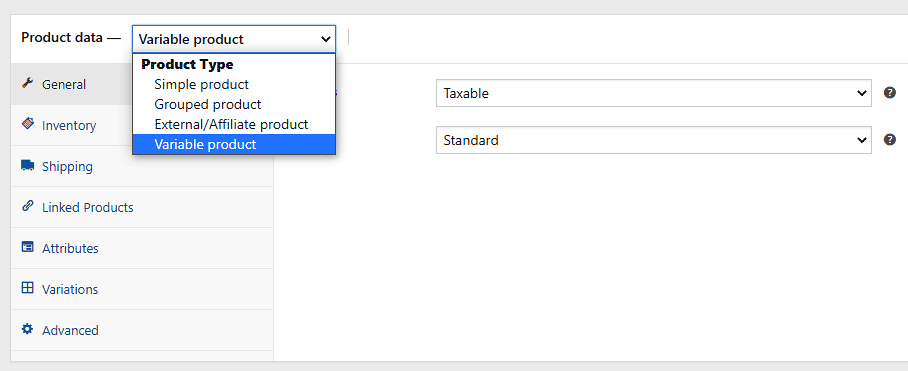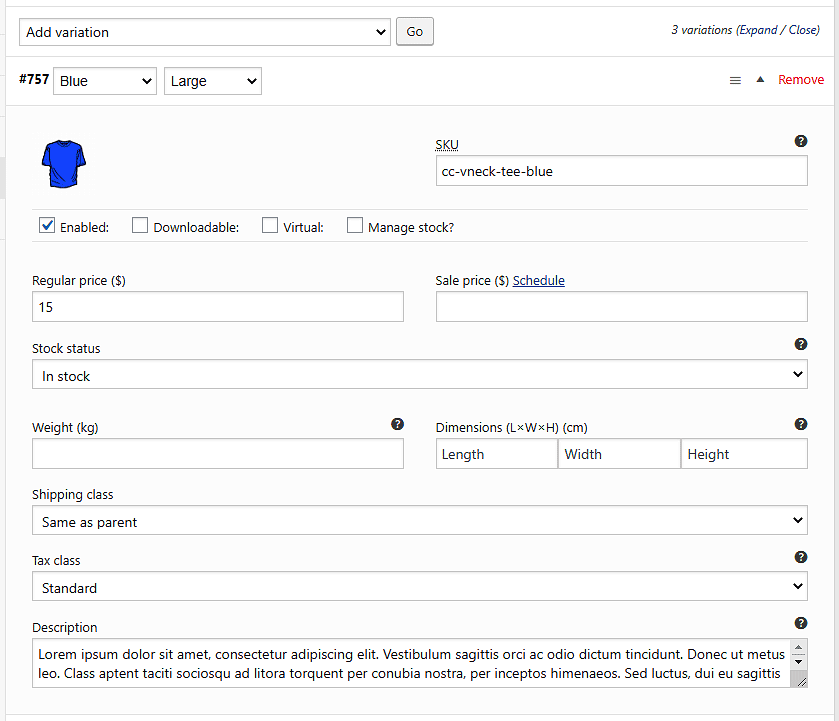Variable products are a product type in Classic Commerce that lets you offer a set of variations on a product, with control over prices, stock, image and more for each variation. They can be used for a product like a shirt, where you can offer large, medium and small sizes, each in a range of different colours.
Adding a Variable Product
There are three stages to adding a variation. You first need to set the product type as a variable product. Then you create attributes that describe the variations you have available (colour, size, weight, etc). Once this is done you can then assign each variation one or more attributes.
Step 1. Set the Product Type
To add a variable product, create a new product or edit an existing one.
- Go to: Classic Commerce > Products.
- Select the Add Product button or Edit an existing product. The Product Data displays.
- Select Variable product from the Product Data dropdown.
Step 2. Add Attributes to Use for Variations
In the Attributes section, add attributes before creating variations — you can use global attributes that are site-wide (and predefined separately) or add custom ones specific to your product.
Global Attributes
To use a global attribute:
- Create global attributes.
- Select one from the dropdown and click Add.
- Choose Select all to add all attributes to the variable product (if applicable).
- Enable the Used for variations checkbox to tell Classic Commerce it’s for your variations.
- Click Save attributes.
Custom Attributes
To add a new attribute specific to this product:
- Select Custom product attribute and click Add.
- Name the attribute (e.g. Size).
- Set values separated by a vertical pipe,
|(e.g., Small | Medium | Large | Extra large). - Check the “Used for variations” box
- Click Save attributes.
Step 3. Add Variations
To add a variation, go to the Variations section in the Product Data meta box. You need to set up Attributes first, or else you will see this message:
You have a choice of manually adding a variation, or creating variations from all of the available attributes.
Manually Add a Variation
- Select Add variation from the dropdown menu, and select Go.
- Select attributes for your variation. To change additional data, click the triangle icon to expand the variation.
- Edit any available data. The only required field is Regular Price.
- Click Save changes.
Creating All Possible Variations
Select Create variations from all attributes to have Classic Commerce create every possible combination of variations and then click Go.
Classic Commerce will create a new variation for each and every possible combination of variation attributes (max 50 per run). If you have more possible combinations you can run it again.
If you have two attributes – color (with values blue and green) and size (with values large and small) it creates the following variations:
- Large Blue
- Large Green
- Small Blue
- Small Green
If you later add additional attributes, it may require the variables to be redefined for the variation combinations to work correctly.
Editing Many Variations
If you have more than 15 variations, use the buttons to navigate forward and backward through the list. Each time you navigate to a new set of variations, the previous set is saved. This ensures that all data is saved.
Setting Defaults
Set defaults you prefer on variations. In the example, no default form values were set, so users can pick any color and size right away from the product page.
If you want a certain variation already selected when a user visits the product page, choose the default form values. This also enables the Add to Cart button to appear automatically on variable product pages.
You can only set defaults after at least one variation has been created.
Adding Variation Data
Each variation can have the following properties.
General
- Enabled – Enable or disable the variation.
- Downloadable – If this a downloadable variation.
- Virtual – If this product isn’t physical or shipped, shipping settings are removed.
- Manage stock? – Whether inventory management is enabled at the variation level
- Regular price (required) – Set the price for this variation.
- Sale price (optional) – Set a price for this variation when on sale.
- Stock status – Whether product is listed as in stock or out of stock
- Weight
- Dimensions
- Shipping class – Same as parent or another predefined class
- Tax class – Tax class for this variation. Useful if you are offering variations spanning different tax bands.
- Description
- Downloadable files – Shows if Downloadable is selected. Add file(s) for customers to download.
- Download limit – Shows if Downloadable is selected. Set how many times a customer can download the file(s). Leave blank for unlimited.
- Download expiry – Shows if Downloadable is selected. Set the number of days before a download expires after purchase.
Inventory Management
Inventory for variable products can be managed on both the product and the variation level.
Сhoose how to manage stock by toggling Enable stock management at product level on the Inventory tab:
The following settings are available if you choose to manage stock on a product level:
- SKU – If you use SKUs, set the SKU or leave blank to use the product’s SKU.
- Manage Stock? – Tick the box to manage stock at the variation level.
- Stock Quantity – Shows if Manage Stock is selected. Input the quantity. Stock for the specific variation, or left blank to use the product’s stock settings.
- Allow Backorders – Choose how to handle backorders.
- Low stock threshold – Enter a number to be notified.
- Sold Individually? – Allow only one to be sold in one order. (This setting is used for the product itself. You cannot set a specific variation to only be sold once per order.)
Choosing to manage stock for variations individually allows you to edit the same properties for each variation.
Set Stock Status can be applied to all variations at once to In stock or Out of stock. Bulk-update under Variations.
Shipping
- Weight – Weight for the variation, or left blank to use the product’s weight.
- Dimensions – Height, width and length for the variation, or left blank to use the product’s dimensions.
- Shipping class – Shipping class can affect shipping. Set this if it differs from the product.
Linked Products
- Upsells
- Cross-sells
- Grouped
If the SKU, weight, dimensions, and stock fields are not set, then it inherits values assigned to the variable product. Price fields must be set per variation.
Add an Image to the Variation
Adding individual images to variations will automatically display that option when the customer selects it from the dropdown box.
- Expand the variation.
- Click the image placeholder.
- Select the image you wish to use.
- Save.
Bulk Editing
You can bulk-edit variations by selecting the specific piece of data you want from the dropdown.
What Customers See
On the frontend, when viewing a variable product, the user is presented with dropdown boxes to select variation options. Selecting options will reveal information about the variation, including available stock and price.
If the user tries to click the greyed out add to cart button before choosing an attribute, a message will appear asking them to select some attributes.
In the product archive page, Add to Cart does not display because a variation must first be chosen before adding to cart on the product page.












